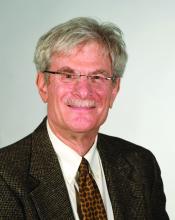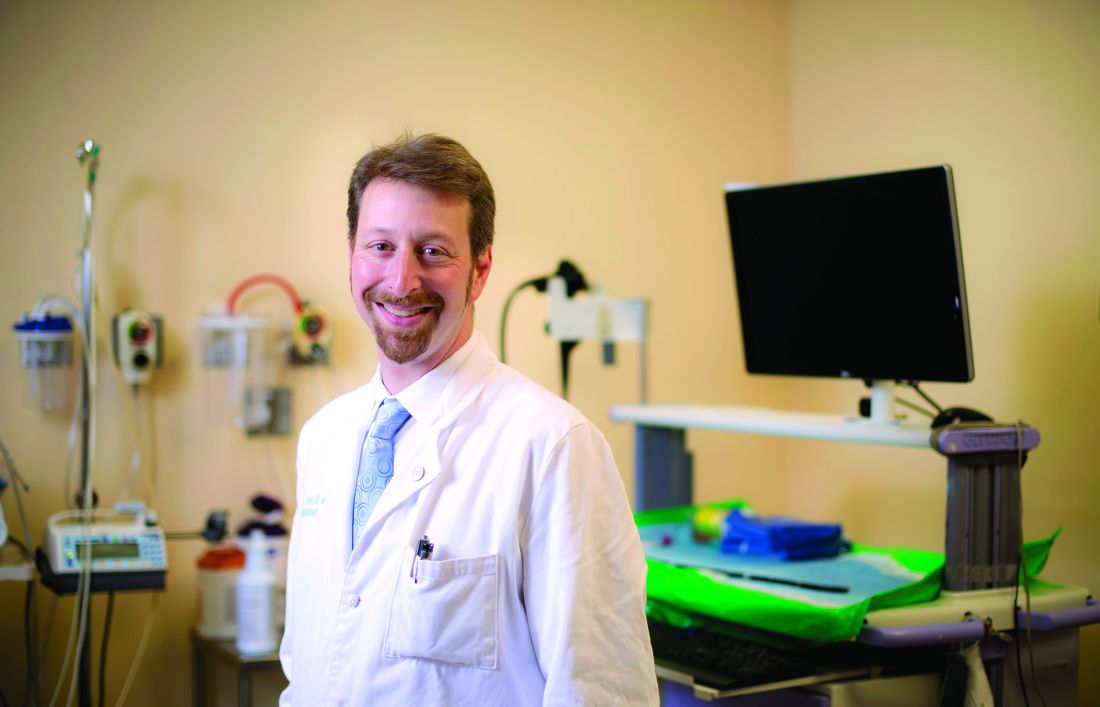User login
Most patients achieved histologic, endoscopic, and symptom improvement with a median of 6 months’ treatment with the interleukin 4 and 13 blocker, and esophageal stricture diameter improved as well, according to a single-center retrospective study in Clinical Gastroenterology and Hepatology.
“Dupilumab has real-world efficacy for a severe EoE population, most of whom would not have qualified for prior clinical trials,” concluded gastroenterologists Christopher J. Lee, MD (lead author), and Evan S. Dellon, MD, MPH, AGAF, of the Center for Esophageal Diseases and Swallowing, at the University of North Carolina School of Medicine in Chapel Hill.
These real-world findings aligned with data from the group’s phase 3 clinical trial.
In addition, several case reports or series have highlighted the real-world efficacy of dupilumab, with a particular focus on pediatric patients and those with other atopic diseases.
“Despite nonresponse to prior treatments, these patients can likely expect to see results similar to what was seen in the clinical trial,” Dr. Dellon said in an interview. “However, it would be good to have similar confirmatory data from other centers, and I’m sure those data will be forthcoming as more EoE patients are treated with dupilumab.”
The placement of dupilumab in the EoE treatment algorithm is still actively being investigated. “While the phase 3 study led to [Food and Drug Administration] approval, it had strict inclusion and exclusion criteria, and some populations were ineligible,” he added. “In particular, the very severe EoE patients who either had a very narrow esophagus where the scope wouldn’t pass, or who had severe strictures and symptoms requiring esophageal dilation and who couldn’t go 6 to 12 months without dilation, couldn’t be enrolled. So the efficacy of dupilumab in this more severe group was not known.”
The group hypothesized that dupilumab would be effective in this population but did not know if the efficacy would be similar to that in the clinical trial. “The overall response rates, which were very similar to what were seen in the phase 3 trial, were surprising,“ Dr. Dellon said.”The other surprising finding was the increase in esophageal caliber, as measured by the size achieved with esophageal dilation.”
The study
The investigators identified 46 patients treated with dupilumab for refractory fibrostenotic EoE at the university’s medical center. All had failed or lost response to one or more standard therapies such as proton pump inhibitors, topical glucocorticosteroids, and a food elimination diet.
Previous treatments also included systemic steroids, cromolyn, ketotifen, montelukast, and 6-mercaptopurine, all with minimal response. Some 85% of patients had undergone an average of 9.0+ 7.0 pre-dupilumab dilations.
The biologic was initially prescribed off-label before FDA approval. Patients received it at a dose of 300 mg subcutaneously either fortnightly (n = 16) or weekly (n = 30), depending on insurance approval and timing of prescription. Length of treatment varied based on the time from prescription to first post-treatment evaluative endoscopy.
Patients showed endoscopic, histologic, and symptomatic improvement on dupilumab compared with both the worst and the pre-dupilumab esophagogastroduodenoscopies.
Among the specific findings:
- Peak eosinophil counts significantly decreased.
- Post-dupilumab histologic response rates were 80% and 57% for fewer than 15 eosinophils per high-power field, and 6 or fewer eosinophils per high-power field, respectively.
- The Endoscopic Reference Score decreased from 5.01 to 1.89 (P < .001 for all).
- Pre-dilation esophageal diameter increased from 13.9 to 16.0 mm (P < .001), although the proportion of strictures was stable.
- Global symptom improvement was reported in 91% of patients (P < .001).
Commenting on the study but not involved in it, David A. Katzka, MD, professor of medicine at Columbia University in New York City, said the findings would be of immediate use to practicing gastroenterologists.
“It’s necessary to do clinical trials, but real-world data make the clinician feel more comfortable in prescribing. Interestingly, I am seeing dupilumab being recommended not just for refractory disease but also as first-line therapy,” he said.
Dr. Dellon noted that the incidence and prevalence of EoE are rising rapidly in the US and around the world. “This increase is outpacing growing recognition of the disease,” he said. “Most likely, environmental factors are driving this change.” He called for studies to determine the long-term efficacy of dupilumab for this severe subgroup — and the potential benefit of moving dupilumab earlier into the treatment algorithm.
The latter is a controversial question, noted Dr. Katzka. “For patients with other indications such as asthma or eczema, dupilumab is the ideal medication,” he said. And it can be a first-line therapy if there are contraindications to alternatives or if compliance will be better with a once-weekly injection as opposed to a twice-daily medication or a food elimination diet. But overall, our more established therapies should be considered first.”
Dr. Katzka emphasized the need to further define EoE phenotypes in order to personalize therapy. “There’s likely a group of patients who should go straight to dupilumab, perhaps those marked by factors such as severity, progression, young age, or other atopic disorders. But we have yet to definitively identify this group.”
The authors reported no specific funding for this analysis. Dr. Dellon reported research funding and/or consulting fees from multiple pharmaceutical companies, including Regeneron/Sanofi, the developers of dupilumab. Dr. Lee had no competing interests to disclose. Dr. Katzka reported consulting for Medtronic, and is an associate editor for GI & Hepatology News.
Most patients achieved histologic, endoscopic, and symptom improvement with a median of 6 months’ treatment with the interleukin 4 and 13 blocker, and esophageal stricture diameter improved as well, according to a single-center retrospective study in Clinical Gastroenterology and Hepatology.
“Dupilumab has real-world efficacy for a severe EoE population, most of whom would not have qualified for prior clinical trials,” concluded gastroenterologists Christopher J. Lee, MD (lead author), and Evan S. Dellon, MD, MPH, AGAF, of the Center for Esophageal Diseases and Swallowing, at the University of North Carolina School of Medicine in Chapel Hill.
These real-world findings aligned with data from the group’s phase 3 clinical trial.
In addition, several case reports or series have highlighted the real-world efficacy of dupilumab, with a particular focus on pediatric patients and those with other atopic diseases.
“Despite nonresponse to prior treatments, these patients can likely expect to see results similar to what was seen in the clinical trial,” Dr. Dellon said in an interview. “However, it would be good to have similar confirmatory data from other centers, and I’m sure those data will be forthcoming as more EoE patients are treated with dupilumab.”
The placement of dupilumab in the EoE treatment algorithm is still actively being investigated. “While the phase 3 study led to [Food and Drug Administration] approval, it had strict inclusion and exclusion criteria, and some populations were ineligible,” he added. “In particular, the very severe EoE patients who either had a very narrow esophagus where the scope wouldn’t pass, or who had severe strictures and symptoms requiring esophageal dilation and who couldn’t go 6 to 12 months without dilation, couldn’t be enrolled. So the efficacy of dupilumab in this more severe group was not known.”
The group hypothesized that dupilumab would be effective in this population but did not know if the efficacy would be similar to that in the clinical trial. “The overall response rates, which were very similar to what were seen in the phase 3 trial, were surprising,“ Dr. Dellon said.”The other surprising finding was the increase in esophageal caliber, as measured by the size achieved with esophageal dilation.”
The study
The investigators identified 46 patients treated with dupilumab for refractory fibrostenotic EoE at the university’s medical center. All had failed or lost response to one or more standard therapies such as proton pump inhibitors, topical glucocorticosteroids, and a food elimination diet.
Previous treatments also included systemic steroids, cromolyn, ketotifen, montelukast, and 6-mercaptopurine, all with minimal response. Some 85% of patients had undergone an average of 9.0+ 7.0 pre-dupilumab dilations.
The biologic was initially prescribed off-label before FDA approval. Patients received it at a dose of 300 mg subcutaneously either fortnightly (n = 16) or weekly (n = 30), depending on insurance approval and timing of prescription. Length of treatment varied based on the time from prescription to first post-treatment evaluative endoscopy.
Patients showed endoscopic, histologic, and symptomatic improvement on dupilumab compared with both the worst and the pre-dupilumab esophagogastroduodenoscopies.
Among the specific findings:
- Peak eosinophil counts significantly decreased.
- Post-dupilumab histologic response rates were 80% and 57% for fewer than 15 eosinophils per high-power field, and 6 or fewer eosinophils per high-power field, respectively.
- The Endoscopic Reference Score decreased from 5.01 to 1.89 (P < .001 for all).
- Pre-dilation esophageal diameter increased from 13.9 to 16.0 mm (P < .001), although the proportion of strictures was stable.
- Global symptom improvement was reported in 91% of patients (P < .001).
Commenting on the study but not involved in it, David A. Katzka, MD, professor of medicine at Columbia University in New York City, said the findings would be of immediate use to practicing gastroenterologists.
“It’s necessary to do clinical trials, but real-world data make the clinician feel more comfortable in prescribing. Interestingly, I am seeing dupilumab being recommended not just for refractory disease but also as first-line therapy,” he said.
Dr. Dellon noted that the incidence and prevalence of EoE are rising rapidly in the US and around the world. “This increase is outpacing growing recognition of the disease,” he said. “Most likely, environmental factors are driving this change.” He called for studies to determine the long-term efficacy of dupilumab for this severe subgroup — and the potential benefit of moving dupilumab earlier into the treatment algorithm.
The latter is a controversial question, noted Dr. Katzka. “For patients with other indications such as asthma or eczema, dupilumab is the ideal medication,” he said. And it can be a first-line therapy if there are contraindications to alternatives or if compliance will be better with a once-weekly injection as opposed to a twice-daily medication or a food elimination diet. But overall, our more established therapies should be considered first.”
Dr. Katzka emphasized the need to further define EoE phenotypes in order to personalize therapy. “There’s likely a group of patients who should go straight to dupilumab, perhaps those marked by factors such as severity, progression, young age, or other atopic disorders. But we have yet to definitively identify this group.”
The authors reported no specific funding for this analysis. Dr. Dellon reported research funding and/or consulting fees from multiple pharmaceutical companies, including Regeneron/Sanofi, the developers of dupilumab. Dr. Lee had no competing interests to disclose. Dr. Katzka reported consulting for Medtronic, and is an associate editor for GI & Hepatology News.
Most patients achieved histologic, endoscopic, and symptom improvement with a median of 6 months’ treatment with the interleukin 4 and 13 blocker, and esophageal stricture diameter improved as well, according to a single-center retrospective study in Clinical Gastroenterology and Hepatology.
“Dupilumab has real-world efficacy for a severe EoE population, most of whom would not have qualified for prior clinical trials,” concluded gastroenterologists Christopher J. Lee, MD (lead author), and Evan S. Dellon, MD, MPH, AGAF, of the Center for Esophageal Diseases and Swallowing, at the University of North Carolina School of Medicine in Chapel Hill.
These real-world findings aligned with data from the group’s phase 3 clinical trial.
In addition, several case reports or series have highlighted the real-world efficacy of dupilumab, with a particular focus on pediatric patients and those with other atopic diseases.
“Despite nonresponse to prior treatments, these patients can likely expect to see results similar to what was seen in the clinical trial,” Dr. Dellon said in an interview. “However, it would be good to have similar confirmatory data from other centers, and I’m sure those data will be forthcoming as more EoE patients are treated with dupilumab.”
The placement of dupilumab in the EoE treatment algorithm is still actively being investigated. “While the phase 3 study led to [Food and Drug Administration] approval, it had strict inclusion and exclusion criteria, and some populations were ineligible,” he added. “In particular, the very severe EoE patients who either had a very narrow esophagus where the scope wouldn’t pass, or who had severe strictures and symptoms requiring esophageal dilation and who couldn’t go 6 to 12 months without dilation, couldn’t be enrolled. So the efficacy of dupilumab in this more severe group was not known.”
The group hypothesized that dupilumab would be effective in this population but did not know if the efficacy would be similar to that in the clinical trial. “The overall response rates, which were very similar to what were seen in the phase 3 trial, were surprising,“ Dr. Dellon said.”The other surprising finding was the increase in esophageal caliber, as measured by the size achieved with esophageal dilation.”
The study
The investigators identified 46 patients treated with dupilumab for refractory fibrostenotic EoE at the university’s medical center. All had failed or lost response to one or more standard therapies such as proton pump inhibitors, topical glucocorticosteroids, and a food elimination diet.
Previous treatments also included systemic steroids, cromolyn, ketotifen, montelukast, and 6-mercaptopurine, all with minimal response. Some 85% of patients had undergone an average of 9.0+ 7.0 pre-dupilumab dilations.
The biologic was initially prescribed off-label before FDA approval. Patients received it at a dose of 300 mg subcutaneously either fortnightly (n = 16) or weekly (n = 30), depending on insurance approval and timing of prescription. Length of treatment varied based on the time from prescription to first post-treatment evaluative endoscopy.
Patients showed endoscopic, histologic, and symptomatic improvement on dupilumab compared with both the worst and the pre-dupilumab esophagogastroduodenoscopies.
Among the specific findings:
- Peak eosinophil counts significantly decreased.
- Post-dupilumab histologic response rates were 80% and 57% for fewer than 15 eosinophils per high-power field, and 6 or fewer eosinophils per high-power field, respectively.
- The Endoscopic Reference Score decreased from 5.01 to 1.89 (P < .001 for all).
- Pre-dilation esophageal diameter increased from 13.9 to 16.0 mm (P < .001), although the proportion of strictures was stable.
- Global symptom improvement was reported in 91% of patients (P < .001).
Commenting on the study but not involved in it, David A. Katzka, MD, professor of medicine at Columbia University in New York City, said the findings would be of immediate use to practicing gastroenterologists.
“It’s necessary to do clinical trials, but real-world data make the clinician feel more comfortable in prescribing. Interestingly, I am seeing dupilumab being recommended not just for refractory disease but also as first-line therapy,” he said.
Dr. Dellon noted that the incidence and prevalence of EoE are rising rapidly in the US and around the world. “This increase is outpacing growing recognition of the disease,” he said. “Most likely, environmental factors are driving this change.” He called for studies to determine the long-term efficacy of dupilumab for this severe subgroup — and the potential benefit of moving dupilumab earlier into the treatment algorithm.
The latter is a controversial question, noted Dr. Katzka. “For patients with other indications such as asthma or eczema, dupilumab is the ideal medication,” he said. And it can be a first-line therapy if there are contraindications to alternatives or if compliance will be better with a once-weekly injection as opposed to a twice-daily medication or a food elimination diet. But overall, our more established therapies should be considered first.”
Dr. Katzka emphasized the need to further define EoE phenotypes in order to personalize therapy. “There’s likely a group of patients who should go straight to dupilumab, perhaps those marked by factors such as severity, progression, young age, or other atopic disorders. But we have yet to definitively identify this group.”
The authors reported no specific funding for this analysis. Dr. Dellon reported research funding and/or consulting fees from multiple pharmaceutical companies, including Regeneron/Sanofi, the developers of dupilumab. Dr. Lee had no competing interests to disclose. Dr. Katzka reported consulting for Medtronic, and is an associate editor for GI & Hepatology News.
FROM CLINICAL GASTROENTEROLOGY AND HEPATOLOGY


